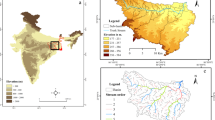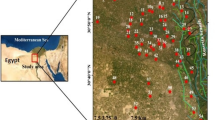Abstract
The assessment of aquifer vulnerability to pollution is crucial for planning a sound management strategy of groundwater quality protection and farmland fertilizer use. This study establishes a reliable model for aquifer vulnerability assessment with an excellent performance for predicting groundwater nitrate-N contamination in the Choushui River alluvial fan, Taiwan based on the DRASTIC method. To promote the prediction performance of aquifer vulnerability assessment, discriminant analysis (DA) was applied to determine the weights of factors in the DRASTIC model by comparing the model results with the observed nitrate-N data. Key factors influencing the presence of groundwater nitrate-N pollution were characterized for different concentration thresholds. The results of analysis reveal that the modified DRASTIC model using DA significantly improves prediction performance for aquifer vulnerability assessment, and groundwater protection zones can be determined correctly based on the modified DRASTIC index. Furthermore, the sensitivity of the factors in the modified DRASTIC model indicates that the depth to the groundwater and aquifer media are critical when the nitrate-N concentration is less than 3 mg/L, while the impact of the vadose zone plays a vital role in controlling nitrate-N pollution of over 5 mg/L.







Similar content being viewed by others
References
Aller L, Bennett T, Lehr JH, Petty RJ, Hackett G (1987) DRASTIC: a standardized system for evaluating ground water pollution potential using hydrogeologic settings. EPA-600/2-87-035, EPA, Washington, DC
Antonakos AK, Lambrakis NJ (2007) Development and testing of three hybrid methods for the assessment of aquifer vulnerability to nitrates, based on the drastic model, an example from NE Korinthia, Greece. J Hydrol 333:288–304
Agriculture Engineering Research Center (2009) Survey, analysis and assessment of groundwater quality in Taiwan areas in 2009. Water Resources Agency, Ministry of Economic Affairs, Executive Yuan, Taiwan, pp 100–102
Assaf H, Saadeh M (2009) Geostatistical assessment of groundwater nitrate contamination with reflection on DRASTIC vulnerability assessment: the case of the upper Litani basin, Lebanon. Water Resour Manag 23:775–796
Baalousha H (2006) Vulnerability assessment for the Gaza Strip, Palestine using DRASTIC. Environ Geol 50:405–414
Baalousha H (2010) Assessment of a groundwater quality monitoring network using vulnerability mapping and geostatistics: a case study from Heretaunga Plains, New Zealand. Agric Water Manag 97:240–246
Babiker IS, Mohamed AAM, Terao H, Kato K (2005) A GIS-based DRASTIC model for assessing aquifer vulnerability in Kakamigahara Heights, Gifu Prefecture, central Japan. Sci Total Environ 345(1–3):127–140
Chen WF, Liu TK (2003) Dissolved oxygen and nitrate of groundwater in Choushui Fan-Delta, western Taiwan. Environ Geol 44(6):731–737
Chen SK, Jang CS, Peng YH (2013) Developing a probability-based model of aquifer vulnerability in an agricultural region. J Hydrol 486:494–504
Chow VT, Maidment D, Mays LW (1988) Applied hydrology. McGraw Hill, New York, p 498
García-Díaz JC (2011) Monitoring and forecasting nitrate concentration in the groundwater using statistical process control and time series analysis: a case study. Stoch Env Res Risk Assess 25(3):331–339
Huan H, Wang J, Teng Y (2012) Assessment and validation of groundwater vulnerability to nitrate based on a modified DRASTIC model: a case study in Jilin City of northeast China. Sci Total Environ 440:14–23
Huang J, Ho M, Du P (2011) Assessment of temporal and spatial variation of coastal water quality and source identification along Macau peninsula. Stoch Env Res Risk Assess 25(3):353–361
Jang CS, Liu CW (2005) Contamination potential of nitrogen compounds in the heterogeneous aquifers of the Choushui River alluvial fan, Taiwan. J Contam Hydrol 79(3–4):135–155
Jang CS, Chen SK, Kuo YM (2012) Establishing an irrigation management plan of sustainable groundwater based on spatial variability of water quality and quantity. J Hydrol 414–415:201–210
Jang CS, Liang CP, Wang SW (2013a) Integrating the spatial variability of water quality and quantity to probabilistically assess groundwater sustainability for use in aquaculture. Stoch Env Res Risk Assess 27(6):1281–1291
Jang CS, Chen SK, Kuo YM (2013b) Applying indicator-based geostatistical approaches to determine potential zones of groundwater recharge based on borehole data. Catena 101:178–187
Knobeloch L, Salna B, Hogan A, Postle J, Anderson H (2000) Blue babies and nitrate-contaminated well water. Environ Health Perspect 108(7):675–678
Lambrakis N, Antonakos A, Panagopoulos G (2004) The use of multicomponent statistical analysis in hydrogeological environmental research. Water Res 38:1862–1872
Leone A, Ripa MN, Uricchio V, Deák J, Vargay Z (2009) Vulnerability and risk evaluation of agricultural nitrogen pollution for Hungary’s main aquifer using DRASTIC and GLEAMS models. J Environ Manag 90(10):2969–2978
Liu CW, Wang SW, Jang CS, Lin KH (2006) Occurrence of arsenic in groundwater of the Choshui river alluvial fan, Taiwan. J Environ Qual 35:68–75
Militino AF, Ugarte MD, Ibáñez B (2008) Longitudinal analysis of spatially correlated data. Stoch Env Res Risk Assess 22(1):49–57
National Research Council (1993) Ground water vulnerability assessment: predictive relative contamination potential under conditions of uncertainty. National Academy Press, Washington, DC, pp 42–63
Panagopoulos GP, Antonakos AK, Lambrakis NJ (2006) Optimization of the DRASTIC method for groundwater vulnerability assessment via the use of simple statistical methods and GIS. Hydrogeol J 14:894–911
Papatheodorou G, Lambrakis N, Panagopoulos G (2007) Application of multivariate statistical procedures to the hydrochemical study of a coastal aquifer: an example from Crete, Greece. Hydrol Process 21:1482–1495
Saidi S, Bouri S, Ben Dhia H, Anselme B (2011) Assessment of groundwater risk using intrinsic vulnerability and hazard mapping: application to Souassi aquifer, Tunisian Sahel. Agric Water Manag 98(10):1671–1682
Sharma S (1996) Applied multivariate techniques. Wiley, New York, pp 264–273
SPSS Inc. (1998) SPSS BASE 8.0- Application Guide. SPSS Inc, Chicago
Swets JA (1995) Signal detection theory and ROC analysis in psychology and diagnostics: Collected Papers. Lawrence Erlbaum Associates
Taiwan Central Geological Survey (CGS) (1999) Project of groundwater monitoring network in Taiwan during first stage: research report of Choushui River alluvial fan. Water Resources Bureau, Taipei, p 383
Taiwan Central Geological Survey (CGS) (2012) Hydrogeological database. Central Geological Survey, Ministry of Economic Affairs, Executive Yuan, Taiwan. http://hydro.moeacgs.gov.tw/
Taiwan Central Weather Bureau (CWB) (2012) Internet application of climate data. Central Weather Bureau, Ministry of Transportation & Communications, Executive Yuan, Taiwan. http://e-service.cwb.gov.tw/wdps/index_net.jsp
Taiwan Sugar Company (TSC) (1999) Groundwater quality by the Taiwan groundwater monitoring network (1/5)—Part 1: the Choushui River alluvial fan. Water Resources Bureau, Taipei, pp 197–204
Taiwan Sugar Company (TSC) (2000) Groundwater quality by the Taiwan groundwater monitoring network (2/5)—Part 1: the Choushui River alluvial fan. Water Resources Bureau, Taipei, pp 140–148
Taiwan Sugar Company (TSC) (2001) Groundwater quality by the Taiwan groundwater monitoring network (3/5)—Part 3: the Choushui River alluvial fan. Water Resources Bureau, Taipei, pp 68–74
Taiwan Sugar Company (TSC) (2002) Groundwater quality by the Taiwan groundwater monitoring network (4/5). Water Resources Bureau, Taipei, pp 48–51
Taiwan Sugar Company (TSC) (2003) Groundwater quality by the Taiwan groundwater monitoring network (5/5). Water Resources Bureau, Taiwan, pp. 5-31-5-35
Taiwan Water Resources Agency (WRA) (2012) Application network of hydrological data. Water Resources Agency, Ministry of Economic Affairs, Executive Yuan, Taiwan. http://gweb.wra.gov.tw/HydroApplication/index.aspx
U.S. EPA (Environmental Protection Agency) (1985) DRASTIC: A standard system for evaluating groundwater potential using hydrogeological settings. Oklahoma WA/EPA Series, Ada, pp 163
Wiggine BA, Andrew RW, Conway RA, Corr CL, Dobratz EJ, Dougherty DP, Eppard JR, Knupp SR, Limjoco MC, Mettenburg JM, Rinehardt JM, Sonsino J, Torrijos RL, Zimmerman ME (1999) Use of antibiotic resistance analysis to identify nonpoint sources of fecal pollution. Appl Environ Microbiol 65:3483–3486
Yang CY, Cheng MF, Tsai SS, Hsieh YL (1998) Calcium, magnesium, and nitrate in drinking water and gastric cancer mortality. Cancer Sci 89:124–130
Acknowledgments
The authors would like to thank the Ministry of Science and Technology, Taiwan for financially supporting this research under Contract No. NSC 98-2116-M-242-001.
Author information
Authors and Affiliations
Corresponding author
Rights and permissions
About this article
Cite this article
Jang, CS., Lin, CW., Liang, CP. et al. Developing a reliable model for aquifer vulnerability. Stoch Environ Res Risk Assess 30, 175–187 (2016). https://doi.org/10.1007/s00477-015-1063-z
Published:
Issue Date:
DOI: https://doi.org/10.1007/s00477-015-1063-z




